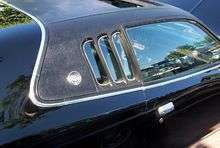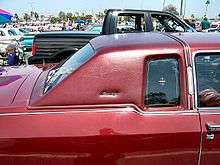Opera window

Opera windows are small porthole sized side windows in the C-pillar of some cars. Typically offered in unison with a vinyl roof, they were a very common design feature of American automobiles during the 1970s. The design "... would prove to be very popular, indicated by its imitation by almost every domestic manufacturer. The opera window was a fixed rear side window surrounded by a vinyl roof."[1]
History

This design element was used during the classical era of automobile styling. For example, “...the Elcar in 1924 was good looking...and even a fabric top in the style of a brougham with oval opera windows framed by landau bars....[2] Opera windows saw their demise in the 1930s. Perhaps the most notable return was the "porthole" in the 1956-57 Ford Thunderbird. It was provided as an option to improve rear-quarter visibility with the removable hardtop in place...[3] Opera windows were once again reintroduced on the 1972 Lincoln Continental Mark IV as an optional luxury feature, but it was almost universally ordered. Adding to the ostentatious appearance, the Lincoln installed a small light at the top of the window on the inside that could be turned on by rear seat passengers. It was separate from the often included rear seat reading lights.

During the 1970s they became a very common design element. “...The hottest thing going was the "porthole" window in the rear side pillar - called "opera windows" that came in during the horse and buggy [era]...[4] Most often, they were applied on two-door hardtop or coupé models and in all types of vehicles, from economy compacts to luxury brands. They also “were recognition elements” in the specialty, personal-sized car market.[5] Practically all cars in the personal luxury market offered these windows as part of their seemingly vintage-oriented styling.
The windows were intended to offset the significant blind spots created by the very wide C-pillars that were characteristic of American cars produced at this time. Even narrow opera windows helped rear visibility.[6] In an age of decreasing dimensions and increasingly common use of non-opening rear side windows on 2-door models, the small opera windows helped rear passengers to be somewhat less claustrophobic.
These windows were usually non-functional; however, in the case of the AMC Matador coupe NASCAR racers, the small windows that came with the Barcelona II trim package actually helped to clean up the aerodynamics when such windows were open to the wind under racing conditions.[7]
In some cars, an additional feature was the so-called opera light that was mounted on the outside of the B-pillar or C-pillar and lit up when the exterior lights were turned on. (See 1980s Lincoln Town Car, 1979-91 Mercury Grand Marquis, or high-end models of the 1988-1990 Oldsmobile 88).
Opera windows had fallen into disuse by the mid-1980s, as changing automotive styles moved away from the upright notchback. Smaller, more aerodynamic cars made opera windows appear gaudy or out of place. Contemporary examples of opera windows are sometimes found on modified or customized automobiles.
Cars with opera windows
This is a partial list of models that had opera windows as standard or optional feature:
- AMC Concord (1978-1982 Coupe, 1980-1983 4-door sedan)
- AMC Matador (1976-78 Coupe)
- Cadillac (Coupe DeVille after 1973; 1971-78 Eldorado; almost all Fleetwood Series 75 cars)
- Chrysler Cordoba
- Chrysler TC by Maserati (1989–1991)
- Daihatsu Charade Runabout (G10/20, 1978–1983)
- Dodge Charger (B-body) (1973–1977)
- Dodge Magnum (1978–1979)
- Dodge Mirada (1980–1983)
- Ford Elite
- Ford Granada (coupe)
- Ford Mustang II Ghia
- Ford Thunderbird
- Ford Torino (1974-1976)
- GM A-body and G-body coupes (Buick Regal, Chevrolet Monte Carlo, Oldsmobile Cutlass Supreme, and Pontiac Grand Prix, 1973-1987)
- Lincoln Continental
- Lincoln Mark series
- Lincoln Town Car
- Mazda RX-5 (1975- 1980)
- Mercury Cougar
- Oldsmobile Toronado (1974–78)
- Toyota Carina Van TA16V/19V (1975-1977)[8] - perhaps the only wagon with opera windows.
- Toyota Crown coupe (1979-1983)
See also
Notes
- ↑ Cadillac Eldorado story, Retrieved on October 22, 2007.
- ↑ William S. Locke (2000) Elcar and Pratt Automobiles: The Complete History, McFarland & Company, ISBN 0-7864-0956-8, page 71.
- ↑ see the 1955-1957 Ford Thunderbird, Retrieved on July 7, 2007.
- ↑ Robert Szudarek (2000) The First Century of the Detroit Auto Show, SAE, ISBN 0-7680-0502-7, page 210.
- ↑ Paul A. Herd and Mike Mueller (1994) Charger, Road Runner, and Super Bee, MotorBooks/MBI Publishing Company ISBN 0-87938-844-7, Page 119.
- ↑ Dodge Magnum story, Retrieved on October 22, 2007.
- ↑ AMC Matador small window for NASCAR, Retrieved on October 22, 2007.
- ↑ カリーナバン 1400ー1600 [Carina Van 1400-1600] (in Japanese), Toyota, December 1975, p. 4, 135741—5012